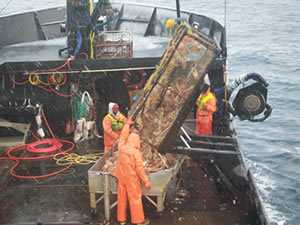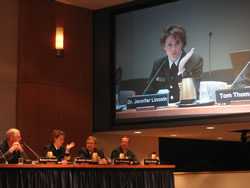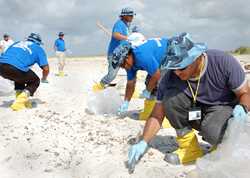NIOSH eNews
Around NIOSH
- World Trade Center Health Program Updates
- NIOSH Congratulates…
- News From Our Partners
- Health Hazard Evaluations (HHE)
- FACE Reports
- Fire Fighter Fatality Investigation and Prevention Reports
- NORA
- r2p Corner
- What’s New on the NIOSH Science Blog?
- Federal Register Notices
- New Communication Products
- Call for Abstracts
- Upcoming Conferences & Workshops
- Word of the Month— Total Worker Health
Volume 9 Number 8 December 2011
From the Director’s Desk
John Howard, M.D.
Director, NIOSH
December eNews 2011
Bearing Witness to the Perfect Storm

Fishermen working on deck
October 2011 marked the 20th anniversary of the original Perfect Storm, the Halloween Nor’easter that ravaged New England in 1991. The phrase "perfect storm" is now used to describe events beyond weather, including political shifts, economic trends, and other drastic confluences of circumstances. But at its core, the perfect storm is a case of occupational fatality—a work-related disaster that cost six commercial fishermen aboard the Andrea Gail their lives while doing their job.
Since the early 1990’s, commercial fishing has been ranked as one of the most dangerous jobs in the United States. That rather infamous distinction continues today. In 1990, NIOSH began working closely with industry partners in Alaska to address the high number of fishing fatalities in the state. Since that time fishing fatalities in Alaska waters have been reduced 42%. Despite 20 years of success in Alaska, commercial fishing is still the most dangerous job in the United States. Beginning in 2004, NIOSH and partners started building on the progress in Alaska to address the hazards that persist in the industry nationwide and identify and validate effective protective measures for other regions of the country.
Last month, the National Transportation Safety Board (NTSB) released a series of recommendations related to safety in the commercial fishing industry. The recommendations are the result of input given by industry experts at the NTSB’s Fishing Vessel Safety Forum held in October 2010 in Washington, DC. The event was held over two days and had six topical panels comprised of invited fishing industry experts including Dr. Jennifer Lincoln of NIOSH’s Alaska Pacific Regional Office who gave testimony during three of the panels. Topics included vessel issues related to safety, lifesaving equipment, safety training for commercial fishermen, and impacts of fisheries management on safety.
Based on the input from the panels and questions asked by the NTSB members, five recommendations were promulgated and presented to the United States Coast Guard (USCG) for consideration in NTSB Safety Recommendations M-11-23 through 27 (http://www.ntsb.gov/doclib/recletters/2011/M-11-023-027.pdf):
- Address intact stability, subdivision, and watertight integrity of fishing vessels under 79 feet in length.
- Require all owners, masters, and chief engineers of commercial fishing industry vessels to receive training and demonstrate competency in vessel stability, watertight integrity, subdivision, and use of vessel stability information.
- Require each person on the deck of a commercial fishing industry vessel to wear a flotation aid at all times.
- Require owners of commercial fishing industry vessels to install fall overboard recovery devices appropriate for the vessel, to periodically ensure the functionality of such equipment, and regularly conduct drills in which crewmembers demonstrate their competence in the use of such devices.
- Require all crewmembers to provide certification of completion of safety training before getting under way on commercial fishing industry vessels.

Dr. Jennifer Lincoln provides testimony at NTSB
The NTSB cited NIOSH’s research into personal flotation devices (PFDs) as a primary source for their recommendation that all fishermen should wear a flotation aid while on deck. Additionally, much of the data supporting all of these recommendations are the result of NIOSH analysis of commercial fishing fatality data through the Commercial Fishing Incident Database. This NIOSH-developed system contains every commercial fishing fatality in the United States since 2000. For example, NIOSH data analysis highlighted the need for stability awareness among crab fishermen in Alaska’s "deadliest catch" in the late 1990s. Working in partnership with the USCG, NIOSH helped develop and evaluate a pre-season dockside inspection program for the Bering Sea crab fleet, which has reduced fatalities in that fishery from an average of eight per year from 1990–1999to less than one per year from 2000–2009. The dubious distinction of being the "deadliest catch" has now been passed along to the scallop and multispecies groundfish fleets on the East Coast of the United States.
This ability to analyze risks in the fishing industry nationwide and promote fishery specific interventions makes the NIOSH commercial fishing safety research program a valued asset to policy makers and the fishing industry. Clear evidence is available to support the NIOSH model of data analysis and targeted interventions with industry partners to affect change among even the most deadly occupations. The recent recommendations from the NTSB, along with the recent Coast Guard Reauthorization Act of 2010 and NIOSH’s continual analysis of fatality data, could be a perfect storm of public health intervention that can address and greatly reduce fatalities in the nation’s deadliest occupation.
We are proud that NIOSH’s research in partnership with the commercial fishing community has pioneered a better understanding of the factors that contribute to the risk of job-related death on the seas, and from that understanding, the development of practical interventions to prevent deaths and serious injuries from occurring.
For more information on the NIOSH commercial fishing safety program or to download the regional fatality summaries and other publications visit /niosh/topics/fishing.
Follow the NIOSH fishing program on Twitter: @NIOSHFishing.
Will YouTube Spark Police Interest in No-Nose Bike Seats?
NIOSH is piloting the use of videos on YouTube to generate curiosity on the benefits of using a no-nose (noseless) bike seat saddle for bicycle police officers. By working with several partners, including the police departments of Chicago, Las Vegas, Miami Beach, San Antonio, and Seattle, NIOSH developed a video with footage of bicycle police officers using a no-nose seat as a part of their daily safety check. Why is a no-nose bike seat part of their daily safety check? View the video at http://www.youtube.com/watch?v=kEzfgS36eEE. For more information on bicycle saddles, go to /niosh/topics/bike/.
Register Now! Personal Protective Technology March Meeting
Registration is now open for the 2012 NIOSH Personal Protective Technology Stakeholder Meeting, Hyatt Regency Pittsburgh International Airport, March 20. The focus of the meeting is personal protective equipment (PPE) selection, use, and expectations and will emphasize PPE in healthcare, mining, pesticide handling, and public safety, as well as a number of PPE-based topics that are mutually relevant across all of these sectors. To register, or for more information, go to https://www.team-psa.com/niosh/stakeholders/2012.
Project ROVER Helps Veterans Return to Work
In a new study, NIOSH and a team of researchers from West Virginia University and Morgantown, WV, area non-profit are partnering to see if dogs can help veterans with post-traumatic stress disorder (PTSD) both recover and return to the workforce. Results of 2011 report on the needs of veterans returning to the labor force showed a higher-than-average unemployment rate and a threefold increase in post-traumatic stress disorder over the last decade. NIOSH has provided funding to allow the WVU-led team to collaborate on Project ROVER, Returning Our Veterans to Employment and Reintegration. Project ROVER is a component of a larger NIOSH initiative related to total worker health and its focus on veterans. Read the full story at http://wvutoday.wvu.edu/n/2011/11/10/west-virginia-university-researchers-to-examine-whether-service-dogs-help-veterans-recover-return-to-workforce or watch a short video at http://www.wboy.com/story/16095842/2011/11/21/comin-ghome. For more information contact Oliver Wirth at owirth@cdc.gov.
Chest Radiographs Evaluation Classification System Updated
Over the past several years, NIOSH has partnered with the International Labour Organization (ILO) and others in an effort to update the ILO classification system used to evaluate chest radiographs for the presence and severity of changes associated with pneumoconiosis so that modern digital chest images could be classified using the system. On November 17, the document Guidelines for the use of the ILO International Classification of Radiographs of Pneumoconioses, revised edition 2011, was posted on the ILO web site http://www.ilo.org/safework/info/publications/WCMS_168260/lang–en/index.htm. The new Guidelines document extends the applicability of the Classification to digital chest images. For more information, see the NIOSH "Digital Imaging Updates" web page /niosh/topics/chestradiography/digital-imaging-updates.html
WTC Health Program Updates
Report from First Scientific and Technical Advisory Committee Meeting
The first meeting of the World Trade Center (WTC) Scientific and Technical Advisory Committee was held on November 9–10 in New York City. The Committee heard presentations from responders and survivors, as well as from the Clinical Centers of Excellence that operate under the WTC Health Program. To view the full agenda and see the presentations, visit the Web site at /niosh/topics/wtc/stac/meetings/agenda.html.
NIOSH Congratulates….
Lisa Steiner, Team Leader, NIOSH Office of Mine Safety and Health Research
The Human Factors and Ergonomics Society of Australia has presented the 2011 Alan Welford Award to "Reducing Control Selection Errors Associated with Underground Bolting Equipment," co-authored by Lisa Steiner of NIOSH. Originally published in the July 2010 issue of Applied Ergonomics, the award recognizes "the best paper on an [sic] human factors and ergonomics topic published in a peer-reviewed journal. The Award is based on the intrinsic merit of the paper itself and its readability for the target audience." To read the full report, go to http://espace.library.uq.edu.au/view/UQ:190647.

Aaron’s winning photo in the OSHA photo contest
Aaron Sussell, NIOSH Health Scientist, Team Leader
Aaron was selected from more than three hundred submissions as the first-place winner of the OSHA public contest for his compelling photograph of workers involved in last summer’s Deepwater Horizon oil cleanup. OSHA held the contest Picture It!: Safe Workplaces for Everyone in celebration of its 40th anniversary. The contest challenged anyone with a passion for photography to capture an image of workplace safety and health and share it with OSHA. The six winning photographs, and seven honorable mentions, can be viewed at http://www.osha.gov/osha40/photo-winners.html. Many of the remaining contest submissions can be viewed on the Department of Labor’s Flickr site http://www.flickr.com/photos/usdol/sets/72157627278407408/.
News from Our Partners
Iowa Public Health Department and Partners Release New Safety Materials
The Iowa Department of Public Health’s Occupational Health and Safety Surveillance Program (IDPH OHSSP) reports that the Iowa work-related fatal injury rate per 100,000 full-time equivalent workers was 5.5 for 2009, compared to 3.5 for all U.S. workers. The IDPH OHSSP also analyzed data from 2003 to 2010; that analysis identified agriculture, forestry, fishing, hunting, transportation, and older workers as specific areas of concern. In response, the IDPH OHSSP and its partners have recently released new materials with the goal of making workplaces safer. These materials include
- The Iowa Fatality Assessment and Control Evaluation (FACE) Program hazard alerts on tractor overturn risks and grain entrapment (www.public-health.uiowa.edu/face/)
- Iowa’s Center for Agricultural Safety and Health (I-CASH), the Great Plains Center for Agricultural Health (GPCAH), and the Iowa Department of Transportation Rural Roadway Safety DVD and toolkit (www.public-health.uiowa.edu/icash/programs/rural-roadway-
safety-video-release.html) - Iowa Rural Health and Safety Resource Plan, 2011 (www.idph.state.ia.us/hpcdp/common/pdf/health_care_access/
2011_safety_resource_plan.pdf) - AgriSafe Network www.agrisafe.org video, My True Heroes (www.youtube.com/watch?v=je2zPusFxDA)
For more information call 800-972-2026 or go to www.idph.state.ia.us.
Game of Logging Training for Farmers
The New York State Fatality Assessment and Control Evaluation (NY FACE) Program provided six training courses to agricultural workers in upstate New York in 2011. A total of 61 farm owners, workers, and agricultural educators attended the training and learned about chainsaw safety features, basic logging safety practices, the use of personal protective equipment, and proper cutting techniques. Each person received Logging Safety: A Field Guide developed by NY FACE. Copies of Logging Safety: A Field Guide and additional NY FACE products are available at http://www.health.ny.gov/environmental/investigations/face/.
WVU Offers Webinar Series, Speakers Cordially Invited
West Virginia University School of Medicine announces the availability of webinars for its Public Health Grand Rounds seminar series. Grand Rounds speakers, such as national public health leaders, WVU faculty and guests from state and local health departments, present their point of view on the different aspects of the patient’s status in relation to etiology, diagnosis, treatment protocol and prognosis. Continuing education credits are also offered. For more information, to view a webinar or to inquire about becoming a speaker, please go to http://www.hsc.wvu.edu/som/cmed/ophp/grandRounds.asp or contact Dr. Rachel Abraham at raabraham@hsc.wvu.edu.
New Findings Show Construction Workers Face Higher Occupational Risks
Dr. Sue Dong of CPWR—the Center for Construction Research and Training— recently presented new research findings at the American Public Health Association conference, showing that construction workers have a significantly higher lifetime risk of premature death due to occupational injury (1/200 chance of dying from a work-related injury over a 45-year career). Given that the Occupational Safety and Health Administration considers a lifetime risk of 1 death in 1,000 workers to be significant, the findings of Dr. Dong et al. are important. To view the presentation go to http://www.cpwr.com/pdfs/Dong_APHA_Lifetime%20risk_103111.pdf or for more information go to http://www.apha.org/about/news/pressreleases/2011/construction+
worker+safety+am+11.htm
New "Nail Gun Safety: The Facts" Website Launched
Dr. Hester Lipscomb of Duke University in conjunction with CPWR-The Center for Construction Research and Training—launched a new website http://www.nailgunfacts.org/ on December 2. The website provides video interviews with workers, and information on how nail guns work and how to prevent nail gun injuries. It also provides access to nail gun research articles from Dr. Lipscomb and her carpenter co-researchers Dennis Patterson and Jim Nolan.
New Health Hazard Evaluation Reports Now Available
 Confined Space Program Recommendations for Dairy Plant Inspectors
Confined Space Program Recommendations for Dairy Plant Inspectors
HHE Program investigators assessed potential hazards encountered by dairy equipment inspectors during entry into confined spaces. Investigators found that inspectors rely on the dairy plant’s confined space entry program and that some plants do not perform air monitoring prior to or during confined space entries. Investigators recommended that all confined spaces be treated as permit-required areas and that inspectors be provided with full body harnesses, lockout/tagout locks, confined space air monitors, and intrinsically safe flashlights. Investigators also recommended that confined space training be specifically created for equipment inspectors in diary plants. A link to the full report is available at /niosh/hhe/whats_new.html.
Noise and Lead Exposures at an Outdoor Firing Range
HHE Program investigators evaluated potential exposure to lead and noise at an outdoor firing range. Investigators found lead on surfaces but determined that employees’ exposure to lead did not exceed occupational exposure limits. Investigators recommended that the range consider using non-lead bullets and primers during classes. Exposures to noise were evaluated and found to exceed the NIOSH-recommended exposure limit; peak noise levels were above 160 decibels during gunfire. Investigators recommended that firing range instructors and students be required to wear dual hearing protection during weapon fire and be trained on the proper use of hearing protection. A links to the full report is available at /niosh/hhe/whats_new.html.
Other News: HHE Program Annual Report
It’s a poster! It’s modern art! It’s a conversation starter! It’s an annual report? To access the 2010 Health Hazard Evaluation Program Annual Report, go to /niosh/hhe/resources.html! This unique format will keep this annual report up on your wall rather than collecting dust on your bookshelf for years to come. To request a paper copy of the 2010 Annual Report, send an email with your mailing address to SEvans2@cdc.gov.
Links to the full reports from these investigations can be found at /niosh/hhe/whats_new.html.
New Fatality Assessment and Control Evaluation (FACE) Program Reports Now Available
New Report: Horticulture Nursery Owner Dies From Slips and Falls From a Tractor
The lack of wearing footwear with proper skid or slip resistance led to the owner slipping and falling from his tractor to the asphalt ground 8 feet below. /niosh/face/stateface/ca/10CA007.html
New Resources for Tub Refinishers
OSHA has identified at least 13 worker deaths, since 2000, related to bathtub refinishing with stripping agents containing methylene chloride. In the majority of the identified cases, the workers were working alone, in poorly ventilated bathrooms, with inadequate respiratory protection and had little or no training on the hazards of the chemicals they were using. Since 2006, three bathtub refinishers in Michigan have died as a result of similar circumstances. A Michigan FACE investigation of one of these deaths is detailed in a new report (/niosh/face/stateface/mi/10MI013.html). Additionally, the Michigan FACE Program released a hazard alert (http://www.oem.msu.edu/userfiles/BathtubRefinishingHA14.pdf) on the topic to inform employers and workers of the hazards of working with methylene chloride-based stripping agents, safe work practices when using them, and alternative paint stripping chemicals and processes.
New Fire Fighter Fatality Investigation and Prevention Program Reports Available
New Report: Fire Fighter Suffers Fatal Heart Attack During Structural Fire
The incident occurred at a residential structure fire. The fire fighter was wearing full turnout gear and self-contained breathing apparatus on-air, climbed a 14-foot ladder to the second floor, and performed fire suppression activities for about 30 minutes. After the fire was brought under control, the fire fighter started to perform overhaul operations when he suddenly collapsed. NIOSH investigators concluded that the physical exertion of responding to the call and suppressing the fire triggered his heart attack, which caused his death. (/niosh/fire/reports/face201116.html)
NORA
National Oil and Gas Extraction Research Agenda Available
The National Oil and Gas Extraction Research Agenda as part of the National Occupational Research Agenda (NORA) has been finalized and is available at /niosh/nora/. The agenda, which was developed by a diverse group of safety and health professionals, identifies five strategic goals designed to address top safety and health concerns and to promote the greatest opportunities to advance safety and health within the oil and gas extraction industry. Contact the NORA coordinator (noracoordinator@cdc.gov) with questions or suggestions or to join others to work on these goals.
r2p Corner
 NIOSH Partnership Continues with NSC
NIOSH Partnership Continues with NSC
On November 1, the National Safety Council (NSC) and NIOSH renewed their collaborative partnership through 2013 to work together to improve safety and health conditions in workplaces throughout the United States and, more specifically, to provide evaluation research, communication, and professional development opportunities for occupational safety and health professionals. The partnership agreement was signed by NIOSH Director John Howard and NSC Director and CEO Janet Froetscher. "We value the partnership of the National Safety Council in working together to identify and seize opportunities to prevent work-related injuries," said Dr. Howard. For more information, go to http://www.nsc.org/Pages/NSCandNIOSH.aspx.
NIOSH Partnership Leads to Advancement in Standards
The Permeation Calculator created by NIOSH National Personal Protective Technology Laboratory has become an adjunct to a new standard from ASTM International (F2815, Standard Practice for Chemical Permeation Through Protective Clothing Materials: Testing Data Analysis by Use of a Computer Program). The free calculator, used for automating and standardizing permeation testing data analysis, can be downloaded at www.cdc.gov/niosh/docs/2007-143C/. For more information, please contact Pengfei Gao at (412) 386-6885 or PGao@cdc.gov, who led the task group of the ASTM International Committee F23.30 that developed the standard.
What’s new on the NIOSH Science Blog?
Buy Quiet
Quieter tools and machines lead to decreased hearing loss among the workers who use them. So why aren’t companies "buying quiet"? Read more about the challenges in this area and what NIOSH is doing to make it easier to "buy quiet." /niosh/blog/nsb110411_buyquiet.html
Puncture: Exposure for Bloodborne Pathogen Exposure
The movie "Puncture" tells the story of a nurse who contracts AIDS from a needle while at work. Unfortunately, this all-too-common scenario is not fiction. Read more about accidental needlesticks and a program from NIOSH that can substantially reduce these injuries. /niosh/blog/nsb111511_needlestick.html
Erionite: An Emerging North American Hazard
Recent cases of lung disease suggest that erionite may pose a greater threat to workers than previously realized. Read more about preventing exposure to erionite in at-risk occupations, such as road construction and maintenance work, and in areas where erionite-containing gravel or soil is present. /niosh/blog/nsb112211_erionite.html
Federal Register Notices
Public Meeting to Discuss NIOSH Carcinogen and RELs Policies
As part of the NIOSH effort to review its cancer (carcinogen) and related policies on recommended exposure limits (RELs), a public meeting will be held Monday, December 12, in Washington, DC, at the Hubert Humphrey Building. Written comments can also be submitted through December 30 for those who cannot attend the meeting. Go to http://edocket.access.gpo.gov/2011/2011-29700.htm for more information.
For a full listing of NIOSH official publications for rules, proposed rules, and notices for 2011, go to /niosh/fedreg.html.
New Communication Products
Flavoring-Related Lung Disease, Information for Healthcare Providers
Information on recognizing, responding, and reporting cases of severe obstructive lung disease associated with those who work with flavoring chemicals containing diacetyl (/niosh/docs/2012-107/)
Restaurant and Food Services: Advancing Priorities Through Research and Partnerships
A two-page synopsis of the Food Services Industry goals established by the NORA Services Sector Council (/niosh/docs/2012-105/)
Rig SMART—Safety Management Assessment for Rig Teams
Contains 35 monthly inspection forms designed for rig workers to document the inspection of tools and equipment commonly found on rotary and workover rigs /niosh/docs/2011-204c/
Diesel Aerosols and Gases in Underground Mines: Guide to Exposure Assessment and Control
The extensive use of diesel-powered equipment in underground mines makes it challenging to control workers’ exposure to submicron aerosols and noxious gases emitted by those engines. In order to protect workers, mines need to establish a comprehensive program based on a multifaceted and integrated approach. (/niosh/mining/pubs/pubreference/outputid3636.htm)
Call for Abstracts
29th Annual Behavioral Risk Factor Surveillance System (BRFSS) Conference, BRFSS: A New Era
Call for abstracts. Deadline for submission is December 30.
http://apps.nccd.cdc.gov/BRFSSAbstractSubmission
2012 Indiana Emergency Response Conference
Call for speaker proposals. Deadline for submission is January 1, 2012.
http://indianaerc.com/default.aspx
XXXth International Symposium of the ISSA Construction Section on Occupational Safety and Health in the Construction Industry
Call for papers. Deadline for submission is January 15, 2012. http://www.issaboston2012.org/callforpapers.html
2012 CDC National Cancer Conference
Call for abstracts. Deadline for submission is January 18, 2012.
http://www.cvent.com/events/2012-cdc-national-cancer-conference/custom-39
-1d3786d4d8f54d269a8796037f07efae.aspx
2012 NSC Congress & Expo—Celebration of the Century
Call for presentations. Deadline for submission is February 3, 2012.
http://www.congress.nsc.org/nsc2012/public/content.aspx?ID=1136
National Conference for Workplace Violence Prevention & Management in Healthcare Settings
Call for papers, posters, and symposia. Deadline for submission is February 17, 2012.
https://webapps.uc.edu/conferencing/Abstracts/Default.aspx?ConferenceID=426
Upcoming Conferences & Workshops
Engineered Solutions for Manual Handling Jobs
February 8–9, 2012, Atlanta, GA
http://www.modexshow.com/education/mmhWorkshop.aspx?ref=attendees
Personal Protective Equipment Selection, Use, and Expectations: NIOSH PPT Stakeholder Meeting
March 20–21, 2012, Pittsburgh, PA
https://www.team-psa.com/niosh/stakeholders/2012
30th International Congress on Occupational Health, Occupational Health for All: From Research to Practice
March 18–23, 2012, Cancun, Mexico
http://www.icohcongress2012cancun.org/1024/ingles/index.aspx?seccion=inicio.html&titulo=Home
Association of periOperative Registered Nurses 59th Annual Congress—Look for us Booth 6053!
March 24–29, 2012, New Orleans, LA
http://www.aorncongress.org/
A comprehensive list of upcoming conferences can be found at /niosh/exhibits.html.
Word of the Month
Erionite — a naturally-occurring fibrous mineral with health effects similar to asbestos
Please send your comments and suggestions to us at nioshenews@cdc.gov.
This newsletter is published monthly via email by the National Institute for Occupational Safety and Health to inform members of the public health community as well as interested members of the general public of Institute related news, new publications, and updates on existing programs and initiatives.
- Page last reviewed: September 9, 2011
- Page last updated: March 12, 2012
- Content source:
- National Institute for Occupational Safety and Health (NIOSH) Office of the Director


 ShareCompartir
ShareCompartir